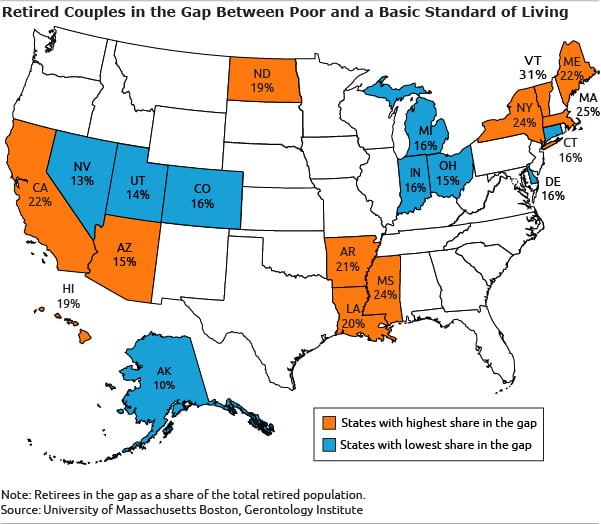
Retiree Living Standards, Ranked by State
How well you will live in retirement will depend on two things: your income and the local cost of living.
A new study that ranks each state based on how many of its retirees can meet a basic standard of living comes up with an interesting combination of places that are financially friendly – or not – to people over 65.
For example, who would expect Mississippi to be in the same company with California?
The cost of living in Mississippi is much lower than in California – and most states. But 31 percent of Mississippi’s retired single people and 24 percent of its retired couples fall into what the study calls the “gap” between being poor and having barely enough income to cover their basic expenses, according to a 50-state analysis by the University of Massachusetts’ Gerontology Institute in Boston.
 A general way to think about the people inhabiting this gap is that, while they are above the poverty line, they are still financially insecure.
A general way to think about the people inhabiting this gap is that, while they are above the poverty line, they are still financially insecure.
“A lot of the folks who find themselves in the gap were middle class,” said Jan Mutchler, a U-Mass Boston professor and institute staff member. They have pensions or other income in addition to Social Security, she said, “and yet they’re still struggling.”
When the poor are added in, a total of 57 percent of Mississippi’s retired singles and 30 percent of its couples do not have the income required to pay for all of their essential household expenses, according to the analysis.
Like Mississippi, the share of older Californians who are feeling financially insecure is also one of the highest in the country: 34 percent of single people and 22 percent of couples. When poor retirees are included, the numbers rise to 54 percent and 27 percent, respectively.
Many people in California and Mississippi are having a difficult time – but for very different reasons.
California is a tough place to be retired because the cost of living is notoriously high. Mississippi’s issue is that workers’ – and retirees’ – incomes are low, which makes it difficult to make ends meet, despite the state’s low cost of living.
The heart of the analysis is an “elder index” specific to each state, which estimates the income necessary to cover essential living costs – rent, food, transportation, health care, a phone, and household items. Vacations, restaurant meals, and entertainment are not included in the estimates.
Some of the states requiring the most income to live include, predictably, Massachusetts, Hawaii, New York, and California – couples there need a minimum of $40,000. Couples can get by on much less in places like Missouri, Ohio, West Virginia, Arkansas, Kentucky and Alabama – $32,000 to $33,000.
Consumers may find this information helpful for planning their own retirement, thinking about relocating to a lower-cost state, or assessing how their parents are doing.
Squared Away writer Kim Blanton invites you to follow us on Twitter @SquaredAwayBC. To stay current on our blog, please join our free email list. You’ll receive just one email each week – with links to the two new posts for that week – when you sign up here. This blog is supported by the Center for Retirement Research at Boston College.
Comments are closed.







When considering where to retire, don’t forget about the availability and cost of health care in your planning. Less of an issue if you are on Medicare, but a major issue for pre-65 retirees.
I find it mildly amusing that the demographic group that is the subject of this article and which relies heavily on subsidized healthcare and retirement income pilloried as socialistic “entitlements” are all in for the party which would like nothing more than to take that away from them. I’ll pop some more corn and watch them go nuts at the Trump rallies, but do not try to make me feel sorry for them.
Having moved to, and subsequently fled from, central New York after retirement, I can confirm the author’s observations. My husband and I certainly entered that state solidly middle-class. He has a decent pension and we had no debt other than our mortgage (for a modest 3 bedroom/2 bath).
Within 2 years we had to patronize food auctions to make ends meet. We weren’t eating out in restaurants, going to movies or concerts or traveling anywhere.
As high as real estate taxes were, school taxes were obscene–as were administrator salaries (i.e., nearly $200,000 in salary and benefits for the superintendent of a district with a grand total of 1,200 students). Municipal services were nearly non-existent.
We now live south of the Mason-Dixon line, where our taxes are (literally) 1/10 of what they were in New York. And no, the public schools are no worse. In fact, just down the road sits a high school ranked in the top 100 in the country.